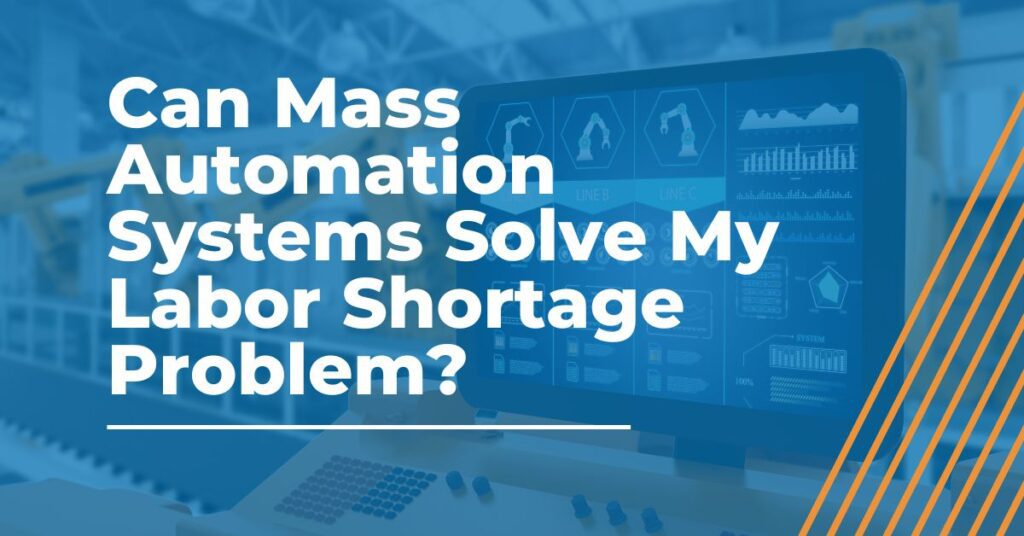
Can Mass Automation Systems Solve My Labor Shortage Problem?
Here on the AMS Freedom of Assembly blog, we often speak about the approaches and benefits of automating individual manufacturing tasks, but what about mass automation of entire production processes and workflows? Would wide-scale automation be an appropriate approach to combating the perpetual labor constraints facing manufacturers today? Let’s find out.
Batch vs Continuous Production
We’ll start with two definitions of different production schemes found in industrial manufacturing:
- Batch production: This manufacturing scheme produces parts and assemblies in groups or “lots,” working the parts from raw to finished conditions until the entire lot is complete. Once a lot is fully processed, the next batch of units can begin. Production stops between batches, resets and restarts from the beginning.
- Continuous production: This scheme produces parts and assemblies continuously such that multiple stages of production occur simultaneously, one after the other, and does not stop between units. Raw materials are constantly fed into the front of the continuous production line, and finished products are continuously discharged from the end of the line.
Most manufacturers producing components for the automotive, medical device, plastic goods and consumer goods markets will employ a mix of batch and continuous processes. Typically, only the largest manufacturers will reach full continuous production, as the investment cost and technical operating requirements often only make financial sense at high unit volumes and high financial margins.
Generally speaking, manufacturers will use batch production in highly repeatable, straightforward work tasks such as precision fastening and nut insertion fabrication steps. The same manufacturer may use a continuous packaging line to package final products, where conveyors feed finished parts into a series of machines that clean, dry, wrap, carton, case, seal, label and palletize products automatically. In this continuous packaging line, human operators only place parts onto the infeed conveyor and do not touch the parts again until they remove a finished pallet to take to the warehouse.
Manufacturers of all sizes can use the distinction between batch and continuous processes to evaluate improvements to their overall workflow. This makes up the building blocks of the next part of our discussion: assessing opportunities to upgrade manual processes to batch processes, and further automate batch processes to work together as continuous processes.
Evaluating Labor-Saving Opportunities for Mass Automation
What do we mean by mass automation? For the purposes of this article, we simply mean “automating multiple separate work processes at the same time, driving them to work together for a total manufacturing process improvement.” Mass automation improvements can take many forms, as in a few of our recent projects:
- For an automotive engine part OEM, we installed two spot welding systems and two leak detection systems that replaced five manual assembly stations for batch production of plastic air intake housings and similar parts. This project freed up the labor of three technicians for each of two production shifts. Those workers were then retrained to work on more complex machining processes that were previously unfilled for months due to hiring difficulties. In this project, the owners looked to introduce multiple batch automation solutions to address very manual existing processes.
- For a medical system manufacturer producing medical gas distribution manifolds that would be installed on emergency response vehicles, the project provided two sanitizing baths, two air knife drying belts and six precision fastening systems to replace manual assembly tabletop stations. We included interconnecting conveyors that would move components between all stations. In this project, labor savings were found by thinking in continuous production terms: keeping technicians focused on their primary work tasks and stations, and using mechanized, inline conveyance to handle, transport and stage parts between stations automatically.
- Another less obvious way that mass automation can be implemented is via control and decision systems that digitally integrate standalone production tasks. For a construction hardware assembly manufacturer, we implemented a plant-wide PLC and HMI system that connected all of their batch production systems together into a single controls platform. With this level of integration, the performance and status of every system in the plant could be seen in one place, as could all alarms, notifications and quality control reports, too.
Central PLC controls were used to “set up the plant” against a singular production recipe controlling each production run, which automatically pushed out the unique configuration settings needed to all machines. In addition, changes to a production run recipe could now be updated in one place and automatically rolled out to each system, without needing to manually upload changes to each of the 20+ machines, as had been done previously. With this project, labor savings were realized across all production, maintenance and QA fronts, and even better, the time saved by reducing manual tasks allowed production capacity to increase by 15 percent without a single new machine.
The pinnacle of mass automation is to provide completely no-touch production lines, where each unit operation needed to produce a finished product is performed automatically, and materials are transported between unit op stations by powered conveyance means. The cost of such automation is often out of reach for specialty, lower-volume manufacturers, but the concepts of batch and continuous production that feed into full automation can still be utilized for mass automation upgrades short of going completely no-touch.
Would Mass Automation Work for You?
We hope that the above examples provide inspiration for how clients can evaluate their own production schemes for mass automation opportunities, either in batch or continuous production terms. AMS provides consulting, evaluation and full delivery of mass automation projects across all of these fronts, and we’d be grateful to discuss what form of mass automation might best benefit your business.
